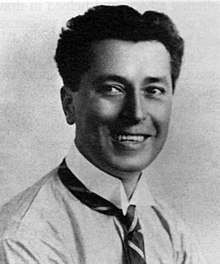G. H. Elliott
G. H. Elliott (November 1882–19 November 1962) was a British music hall singer and dancer. Known as the "Chocolate Coloured C**n", he performed with a painted brown face and dressed entirely in white: white top hat, white tail-coat which came down well below the knees, white gloves, white tie or cravat, white trousers, white shoes and white cane.

Life and career
He was born George Henry Elliott in Rochdale, Lancashire, in 1882.[1] He and his family emigrated to the United States when he was four. There he played juvenile parts on stage including the title role in Little Lord Fauntleroy. He was a member of the Primrose West Minstrels[2] at the age of nine where he first blacked up.
The family returned to Britain in 1901, where he continued to perform on the music hall stage. He made his London debut on 10 March 1902 at Sadler's Wells Theatre.[3] After a number of years treading the boards he rose to top of the bill. He was influenced by Eugene Stratton, who also used to black up, and he sang some of Stratton's songs, particularly "Lily of Laguna", which he sang in tribute to his hero. Among the songs particularly associated with him are "Idaho", a"I Used To Sigh for the Silvery Moon" and "Sue, Sue, Sue".
He appeared in one film only, Music Hall (1934), although it is a repeated misconception that a blackface singer who performed his (formerly Eugene Stratton's) song "Lily of Laguna" in Those Were the Days (1934) was him. He made several appearances in television variety shows and was the subject of This Is Your Life in 1957 when he was surprised by Eamonn Andrews at the King's Theatre in Hammersmith, London (located at 178-180 Hammersmith Road and demolished in 1963).[4]
Elliott appeared in three Royal Variety Performances, in 1925, 1948 and 1958. He made over 100 records, his first on a wax cylinder and his last in 1960.
He was married twice, first to Emily Hayes, who died in 1940, and then to Florence May Street, known as June. She had been an acrobat in acts as various as the Martinez Troupe/Duo, and Sereno (Harry Sereno) and June.
Elliott retired to Rottingdean, near Brighton in Sussex, where he lived in a cottage he named "Silvery Moon" after his song "I Used to Sigh for the Silvery Moon". He is buried in the churchyard of St Margaret's Church, Rottingdean.[5] His gravestone shows a stage with curtains drawn back, and bears the words: "The last curtain call for G H Elliott the Chocolate Coloured Coon who died 19 November 1962. Dearly loved R.I.P".[6] Because of racial sensitivities surrounding some of the words used in the epitaph, the memorial was removed to a safe location in June 2020.[7]
Bibliography
Elliott, June: Sawdust to Stardust; Elliott, G.H.: Chocolate & Cream; Malvern Link: G. Higgins, 2001.
Notes
- Michael Pickering, ‘Elliott, George Henry (1882–1962)’, Oxford Dictionary of National Biography, Oxford University Press, 2004; online edn, Sept 2013 accessed 16 April 2017
- Gammond, Peter (1991). The Oxford Companion to Popular Music. Oxford University Press. p. 176. ISBN 978-0-19-311323-7.
- Ed. by H. C. G. Matthew, in assoc. with the British Academy (2004). Oxford Dictionary of National Biography : from the earliest times to the year 2000 (1. publ. ed.). Oxford: Oxford Univ. Press. pp. 202–3. ISBN 0-19-861368-7.
- "G H Elliott". Bigredbook.info. Retrieved 1 July 2020.
- Dale, Antony (1989). Brighton Churches. London EC4: Routledge. p. 212. ISBN 0-415-00863-8.CS1 maint: location (link)
- "The Times Obituary". 20 November 1962: 15. Cite journal requires
|journal=(help) - In the matter of St Margaret's Rottingdean (Consistory Court [2020] ECC Chi 4 15/06/2020). Text
References
Hudd, Roy & Hintin, Philip. Cavalcade of Variety Acts: a Who Was Who of Light Entertainment, 1945–60 p. 52, Robson Books, 1997; ISBN 978-1-86105-115-8.